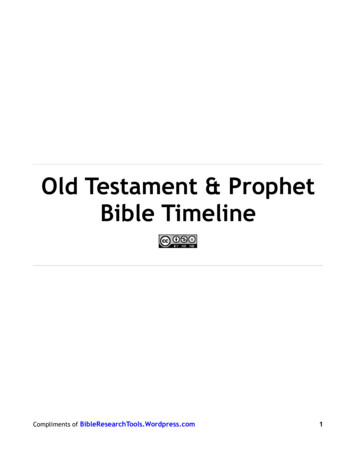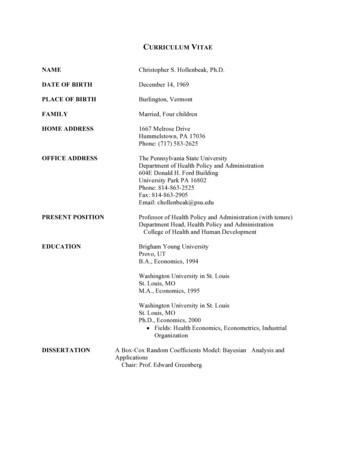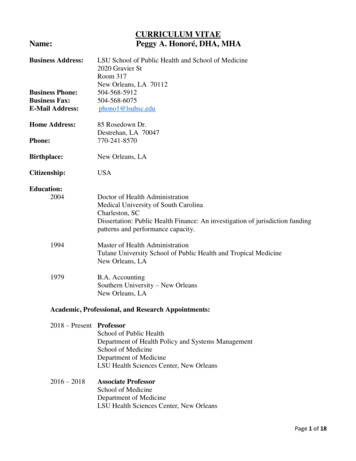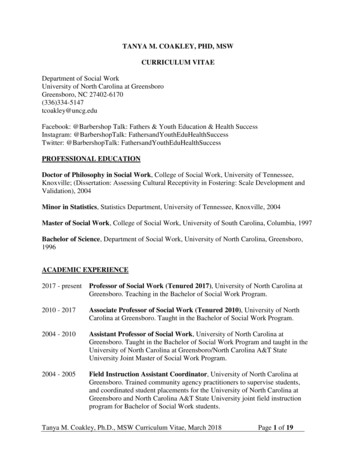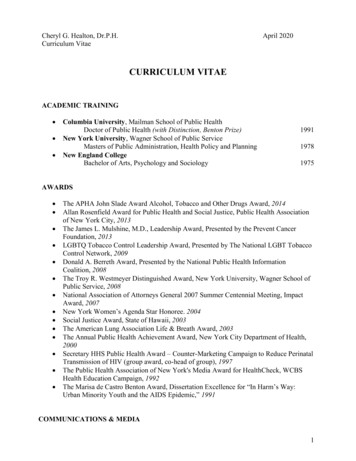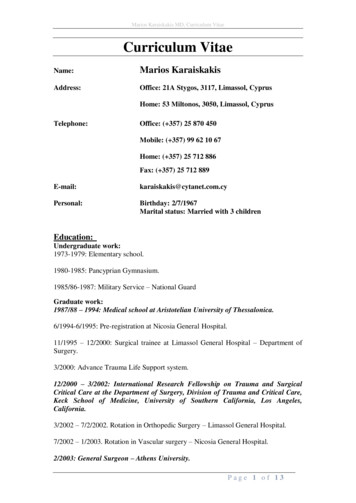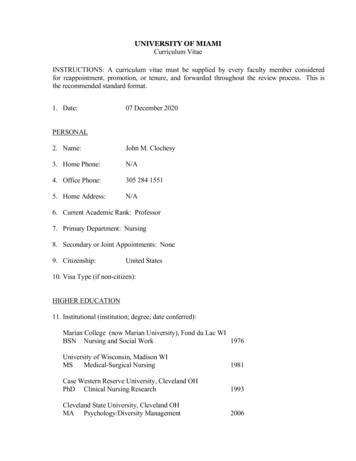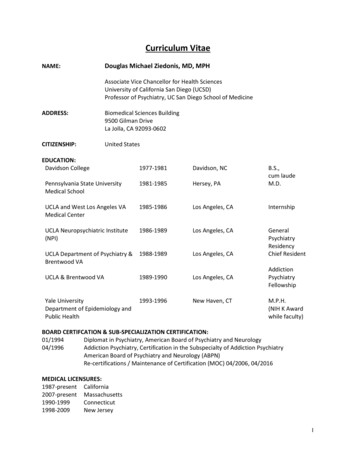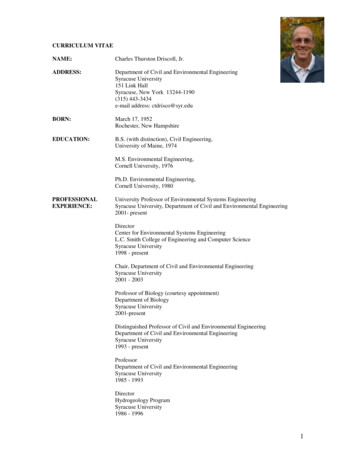
Transcription
CURRICULUM VITAENAME:Charles Thurston Driscoll, Jr.ADDRESS:Department of Civil and Environmental EngineeringSyracuse University151 Link HallSyracuse, New York 13244-1190(315) 443-3434e-mail address: ctdrisco@syr.eduBORN:March 17, 1952Rochester, New HampshireEDUCATION:B.S. (with distinction), Civil Engineering,University of Maine, 1974M.S. Environmental Engineering,Cornell University, 1976Ph.D. Environmental Engineering,Cornell University, 1980PROFESSIONALEXPERIENCE:University Professor of Environmental Systems EngineeringSyracuse University, Department of Civil and Environmental Engineering2001- presentDirectorCenter for Environmental Systems EngineeringL.C. Smith College of Engineering and Computer ScienceSyracuse University1998 - presentChair, Department of Civil and Environmental EngineeringSyracuse University2001 - 2003Professor of Biology (courtesy appointment)Department of BiologySyracuse University2001-presentDistinguished Professor of Civil and Environmental EngineeringDepartment of Civil and Environmental EngineeringSyracuse University1993 - presentProfessorDepartment of Civil and Environmental EngineeringSyracuse University1985 - 1993DirectorHydrogeology ProgramSyracuse University1986 - 19961
Professor of Chemistry (courtesy appointment)Department of ChemistrySyracuse University1993-presentProfessor of Earth Sciences (courtesy appointment)Department of Earth SciencesSyracuse University1989 - presentVisiting ScientistInstitute of Ecosystem StudiesMillbrook, New York1987 – 1988Visiting ScholarUniversity of VirginiaCharlottesville, VirginiaJanuary-June 2006Associate ProfessorCivil Engineering DepartmentSyracuse University1983 - 1985Visiting ScientistDepartment of Soil Science and GeologyAgricultural UniversityWageningen, the Netherlands1983Assistant ProfessorCivil Engineering DepartmentSyracuse University, 1979 - 1983AREAS OFRESEARCH:Aquatic ChemistryBiogeochemistryEcosystem ScienceEnvironmental Quality ModelingLimnologySoil ChemistryHONORS AND AWARDS: Batsheva de Rothschild Fellowship, Israel Academy of Sciences and Humanities,Lectureship at Israel University, 2015Adirondack Research Consortium, Adirondack Achievement Award, 2012National Research Council, Board of Environmental Studies and Toxicology, 2011-2017U.S. National Committee for Soil Science, The National Academies, 2008-2010Guest on National Public Radio Science Friday, 19 January 2007Syracuse University Excellence in Graduate Education Faculty Recognition Award,March 2007National Academy of Engineering, 2007-presentNational Research Council (NRC) Committee on Everglades Restoration, 2006-present2
Air Quality Working Group, State of the Nations Ecosystems, Heinz Center, 2005-2007National Research Council (NRC) Committee on Collaborative Larger Scale EngineeringAnalysis for Environmental Research (CLEANER), 2005-2006Institute of Scientific Information, Highly Cited Researcher for Engineering andEnvironmental Science, 2003-presentNational Research Council (NRC) Committee on Air Quality Management in the UnitedStates, 2001-2004Co-convener of AGU Chapman Conference on Nitrogen Cycling in ForestedCatchments, 1996American Chemical Society, Syracuse Section Research Award, 1994Chairman of Gordon Conference on Hydrologic, Geochemical and Biological Processesin Forested Catchments, 1993IBM Corporation Environmental Research Program Award, 1993Syracuse University, College of Engineering, Anaren Microwave Award for Excellencein Engineering Scholarship, 1989Chairman of Working Group on Mapping Critical Loads, United Nations Convention onLong-Range Transboundary Air Pollution, 1989U.S. Delegate to ECE Workshop to Establish Target Loads of Sulfur and Nitrogen,1988U.S. Representative on International Panel to Evaluate Role of Atmospheric NitrogenDeposition in Surface Water Acidification, 1987Sigma Xi Research Award, 1987Sigma Xi, 1986Syracuse University Chancellor's Citation for Academic Achievement, 1985Presidential Young Investigator Award, 1984National Academy of Sciences, Panel on Acidification Processes, 1984Research Fellowship, Agricultural University, Wageningen, the Netherlands, 1983Chi Epsilon, 1980Tau Beta Pi, Maine Alpha, 1974EXPERT WITNESS EXPERIENCE:Court:Expert witness in the Maine People’s Alliance and Natural Resources Defense Council,Inc. v. Holtrachem Manufacturing Company and Mallinckrodt in 2013-2014 Dr.Driscoll provided both deposition and trial testimony.Expert witness in United States et al. v. Westvaco Corporation and Luke Mill Companyin 2012. Dr. Driscoll provided deposition and trial testimony.Expert witness in United States et al. v. Cinergy et al. in 2009-2010 and United States etal. v. Cinergy et al. in 2008-2009. Dr. Driscoll provided both deposition andtrial testimony.Expert witness in North Carolina v. Tennessee Valley Authority in 2006-2008. Dr.Driscoll provided both deposition and trial testimony.Expert witness in United States, et al. v. American Electric Power, et al. Dr. Driscollprovided deposition testimony once in that case in August 2006.Expert witness in United States, et al. v. Ohio Edison, et al. Dr. Driscoll provideddeposition testimony twice in that case in the spring of 2004.EXPERT TESTIMONY:Congressional:2012 – U.S. Senate, Committee on Environment and Public Works Subcommittee onClean Air and Nuclear Safety2007 – U.S. House of Representatives House Subcommittee on Water Resources andEnvironment Hearing on Nonpoint Source Pollution: Atmospheric Depositionand Water Quality2001 – U.S. House of Representatives Committee on Science Hearing on Acid Rain: TheState of Science and Research Needs for the Future3
1988 – Senate Commerce Committee Hearing on the Role of Atmospheric Deposition inEutrophication of Coastal Waters: Atmospheric Nitrogen Deposition andWatershed Nitrogen LossesState Legislature:2009 – New York State Assembly Subcommittee on Environmental ConservationHearing on Mercury Exposure2005 – New York State Assembly Subcommittee on Environmental ConservationHearing on Water Quality in the AdirondacksPUBLICATIONS: (*indicates non peer-reviewed publication; over 410 peer-reviewed publications)Books:Pardo, L.H., M.J. Robin-Abbott, C.T. Driscoll (eds). 2011. Assessment of Nitrogen Deposition Effects andEmpirical Critical Loads of Nitrogen for Ecoregions of the United States. Gen. Tech. Rep. NRS80. Newtown Square, PA: U.S. Department of Agriculture, Forest Service, Northern ResearchStation. 291 p.Peters, D.P.C., C.M. Laney, A.E. Lugo, S.L. Collins, C.T. Driscoll, P.M. Groffman, J.M. Grove, A.K.Knapp, T.K. Kratz, M.D. Ohman, R.B. Waide, and J. Yao. 2011. Long-term Trends in EcologicalSystems: A Basis for Understanding Responses to Global Change. USDA Agricultural ResearchService Publication No. 1931. Washington, DC. 378 p.Jenkins, J., K. Roy, C. Driscoll, C. Buerkett. 2007. Acid Rain and the Adirondacks: An EnvironmentalHistory. Cornell University Press, Cornell, NY. 246 p.Driscoll, C.T. (ed.) 1996. Experimental Watershed Liming Study. Kluwer Academic Publishers, Dordrecht,the Netherlands. 248 p.Binkley, D., C.T. Driscoll, H.L. Allen, P. Schoenberger and D. McAvoy. 1989. Impacts of AcidicDeposition: Context and Case Studies of Forest Soils in the Southeastern U.S., Ecological Studies72. Springer-Verlag, New York. 149 p.Articles in Press or Early Online:Driscoll, C. T., K. M. Driscoll, H. Fakhraei, and K. Civerolo. in press. Long-term Temporal Trends andSpatial Patterns in the Acid-Base Chemistry of Lakes in the Adirondack Region of New York inResponse to Decreases in Acidic Deposition. Atmospheric Environment.Fakhraei, H., C. T. Driscoll, J. R. Renfro, M. A. Kulp, T. Blett, E. F. Brewer, and J. Schwartz. in press.Critical Loads and Exceedances for Nitrogen and Sulfur Atmospheric Deposition in Great SmokyMountains National Park, USA. Ecosphere.Gerson, J. R. and C. T. Driscoll. in press. Is mercury in remote forested watershed in the AdirondackMountains responding to recent decreases in emissions? Environmental Science and Technology.Articles in Review:Arseneau, K. M. A., C. T. Driscoll, C. M. Cummings, G. Pope, and B. F. Cumming. in review. Adirondack(NY, USA) reference lakes show a pronounced shift in chrysophyte species composition since ca.1900. Journal of Paleolimnology.Belyazid, S., J. Phelan, C. Clark, L. Adams, B. Nihlgard, H. Sverdrup, C. T. Driscoll, I. Fernandez, J.Aherne, S. W. Bailey, M. Arsenault, N. L. Cleavitt, B. Engstrom, R. Dennis, D. Sperduto, and D.Werier. in review. Assessing the effect of climate change and air pollution on biogeochemistry and4
plant diversity in Northeastern U.S. hardwood forests: Step 1 model setup and evaluation. WaterAir and Soil Pollution.Berton, R., D. G. Chandler, and C. T. Driscoll. in review. Discharge responses to regime shifts of AMOand NAO in the northeastern United States. Hydrological Sciences Journal.Bushey, J. T., P. M. Groffman, C.T. Driscoll and G. T. Fisher. in review. Mercury patterns and flux underbase flow conditions in an urban watershed ecosystem. Environmental Pollution.Capps, S. L., C. T. Driscoll, H. Fakhraei, P. H. Templer, K. J. Craig, J. B. Milford, and K. F. Lambert. inreview. Estimating potential productivity co-benefits for crops and trees from reduced ozone withU.S. coal power plant carbon standards. Journal of Geophysical Research: Atmospheres.Caputo, J., C. Beier, H. Fakhraei, and C. T. Driscoll. in review. Impacts of acidification and potentialrecovery on the expected value of recreational fisheries in Adirondack lakes (USA). Environ SciTechnol.Christenson, L. M., H. Clark, L. Livingston, E. Hefferenan, J. L. Campbell, C. T. Driscoll, P. M. Groffman,T. J. Fahey, M. C. Fisk, M. J. Mitchell, and P. H. Templer. in review. Winter climate change andsoil faunal distribution and abundance: Implications for N cycling in the northern forest.Northeastern Naturalist.Denkenberger, J. S., C. T. Driscoll, B. A. Branfireun, A. Warnock, and E. Mason. in review. Watershedinfluences on mercury in tributaries to Lake Ontario. Biogeochemistry.Driscoll, C. T., H. Fakhraei, C. E. Johnson, and K. M. Driscoll. in review. Response of ecosystems of theAdirondack region of New York to decreases in acid deposition: A roadmap to recovery?BioScience.Eger, C., D. G. Chandler, B. Kasaee Roodsari, C. Davidson, and C. T. Driscoll. in review. Water BudgetTriangle: Framework to compare the hydrologic function of stormwater infrastructure. EcologicalEngineering.Fakhraei, H., C. T. Driscoll, M. Kulp, J. Renfro, T. Blett, P. Brewer and J. Schwartz. in review. Sensitivityand uncertainty analysis of PnET-BGC to inform the development of Total Maximum Daily Loadsof acidity in the Great Smoky Mountains National Park. Environmental Modelling & Software.Galicinao, G. A., M. T. Auer, D. A. Matthews, N. P. Revsbech, S. Todorova, S. W. Effler, and C. T.Driscoll. in review. Microprofiling and microcosm studies of methylmercury flux inhibition inlake sediments amended with nitrate and oxygen. Environmental Research.Todorova, S., C. T. Driscoll, D. A. Matthews, S. W. Effler, M. Montesdeoca, and D. Lichtenstein. inreview. Evaluating the drivers for the seasonal and long-term changes of mercury concentrationsin mixed zooplankton communities in a freshwater lake. Science of the Total Environment.Warren, D. R., C. E. Kraft, D .C. Josephson and C. T. Driscoll. in review. Acid Rain Recovery, ChangingClimate and the future of Coldwater Fisheries. Global Change Biology.Yang, Y., R. D. Yanai, M. R. Montesdeoca, and C. T. Driscoll. in review. Measuring mercury in wood:Important but challenging. Science of the Total Environment.Yu, R.-Q., I. Adatto, J. K. Schaefer, T. Barkay, and M. E. Hines. in review. Bacterial diversity in an acidicfreshwater wetland: Potential links to mercury methylation. Journal of Geological LettersArticles Published:Baldigo, B. P., K. M. Roy and C. T. Driscoll. 2016. Response of fish assemblages to declining acidicdeposition in Adirondack Mountain lakes 1984-2012. Atmospheric Environment.doi:10.1016/j.atmosenv.2016.06.049.5
Berton, R., C. T. Driscoll and D. G. Chandler. 2016. Changing climate increases discharge and attenuatesits seasonal distribution in the northeastern United States. Journal of Hydrology:Regional Studies5:164-178 doi:10.1016/j.ejrh.2015.12.057.Buonocore, J. J., K. F. Lambert, D. Burtraw, S. Sekar, and C. T. Driscoll. 2016. An analysis of costs andco-benefits for a U.S. power plant carbon standard. Plos One, 11(6), , C. M. G., D. L. Todorov, C. T. Driscoll, and M. R. Montesdeoca. 2016. Water quantity andquality response of a green roof to storm events: Experimental and monitoring observations.Environmental Pollution.Crumley, K. M., M. A. Teece, J. B. Crandall, A. K. Sauer, and C. T. Driscoll. 2016. Effects of nitrogendeposition on nitrogen acquisition by Sarracenia purpurea in the Adirondack Mountains, NewYork, USA. The Journal of the Torrey Botanical Society 143:8-20.Durán, J., J. L. Morse, P. M. Groffman, J. L. Campbell, L. M. Christenson, C. T. Driscoll, T. J. Fahey, M.C. Fisk, G. E. Likens, J. M. Melillo, M. J. Mitchell, P. H. Templer and M. A. Vadeboncoeur.2016. Climate change decreases nitrogen pools and mineralization rates in northern hardwoodforests. Ecosphere 7 (3) e01251.10.1002/ecs2.1251.Fuss, C., C. T. Driscoll, M. B. Green, and P. M. Groffman. 2016. Hydrologic flowpaths during snowmelt inforested headwater catchments under differing winter climatic and soil frost regimes. HydrologicalProcesses. DOI: 10.1002/hyp.10956.Gerson, J. R., C. T. Driscoll, and K. M. Roy. 2016. Patterns of nutrient dynamics in Adirondack lakesrecovering from acid deposition. Ecological Applications. doi:10.1890/15-1361.1.Gustin, M.S., D. C. Evers, M. S. Bank, A. Hammerschmidt, A. Pierce, N. Basu, J. D. Blum, P. Bustamante,C. Chen, C. T. Driscoll, M. Horvat, D. Jaffe, J. Pacnya, N. Pirrone and N. E. Selin. 2016.Importance of Integration and Implementation of Emerging and Future Mercury Research into theMinamata Convention. Environmental Science and Technology 50: 2767-2770.Kang, P.-G., M. J. Mitchell, P. J. McHale, C. T. Driscoll, M. R. McHale, S. P. Inamdar, and J.-H. Park.2016. Important of within-lake processes in affecting the dynamics of dissolved organic carbonand dissolved organic and inorganic nitrogen in an Adirondack forested lake/watershed.Biogeosciences 13: 2787-2801.Luo, Y., L. Duan, C. T. Driscoll, G. Xu, M. Shao, M. Taylor, S. Wang, and J. Hao. 2016.Foliage/atmosphere exchange of mercury in a subtropical coniferous forest in south China, Journalof Geophysical Resesearch: Biogeosciences, 121, doi:10.1002/2016JG003388.Pourmokhtarian, A., C. T. Driscoll, J. Campbell, K. Hayhoe, A. M. K. Stoner, M. B. Adams, D. Burns, I.Fernandez, M. J. Mitchell, J. B. Shanley. 2016. Modeled Ecohydrological responses to climatechange at seven small watersheds in the northeastern U.S. Global Change Biology.doi:10.1111/gcb.13444Rosi-Marshall, E. J., E. S. Bernhardt, D. C. Buso, C. T. Driscoll and G. E. Likens. 2016. Acid rainmitigation experiment shifts a forested watershed from a net sink to a net source of nitrogen.PNAS, 113(27), 7580–7583. doi:10.1073/pnas.1607287113.Shao, S., C. T. Driscoll, C. E. Johnson, T. J. Fahey, J. J. Battles, and J. D. Blum. 2016. Long-termresponses in soil solution and stream-water chemistry at Hubbard Brook after experimentaladdition of wollastonite. Environmental Chemistry, 13(3), 528-540. doi:10.1071/EN15113.Sunderland, E., C. T. Driscoll, J. Hammitt, P. Grandjean, J. Evans, J. D. Blum, C. Chen, D. C. Evers, D.Jaffe, R. Mason, S. Goho, and W. Jacobs. 2016. Benefits of regulating hazardous air pollutantsfrom coal and oil-fired utilities in the United States. Environmental Science & Technology 50:2117 -2120.6
Templer, P. H., K. F. Lambert, M. Weiss, J. S. Baron, C. T. Driscoll, and D. R. Foster. 2016. Usingscience-policy integration to improve ecosystem science and inform decision-making: Lessonsfrom U.S. LTERs. Special Session at 100th Ecological Society of America Meeting in Baltimore,MD, 12 August 2015, Meeting Reviews. Bulletin of the Ecological Society of America 97:123128.Blackwell, B. D., and C. T. Driscoll. 2015. Deposition of mercury in forests along a montane elevationgradient. Environmental Science & Technology 49:5363-5370.Blackwell, B. D., and C. T. Driscoll. 2015. Using foliar and forest floor mercury concentrations to assessspatial patterns of mercury deposition. Environmental Pollution 202:126-134.*Driscoll, C. T., C. G. Eger, D. G. Chandler, C. I. Davidson, B. K. Roodsari, C. D. Flynn, K. F. Lambert,N. D. Bettez, and P. M. Groffman. 2015. Green Infrastructure: Lessons from Science and Practice.A publication of the Science Policy Exchange. 32 pages.Driscoll, C. T., K. F. Lambert, D. Burtraw, J. J. Buonocore, S. B. Reid, and H. Fakhraei. 2015. US powerplant carbon standards and clean air and health co-benefits. Nature Climate Change 5:535-540.Fahey, T. J., P. H. Templer, B. T. Anderson, J. J. Battles, J. G. Campbell, C. T. Driscoll, A. J. Fusco, M. B.Green, K.-A. S. Kassam, N. L. Rodenhouse, L. Rustad, P. G. Schaberg, and M. A. Vadeboncoeur.2015. The promise and peril of intensive-site-based ecological research: Insights from theHubbard Brook ecosystem study. Ecology 96:885-901.Fakhraei, H., and C. T. Driscoll. 2015. Proton and aluminum binding properties of organic acids in surfacewaters of the Northeastern, USA. Environmental Science & Technology 49:2939-2947.Fenn, M. E., C. T. Driscoll, Q. Zhou, L. E. Rao, T. Meixner, E. B. Allen, F. Yuan, and T. J. Sullivan. 2015.Use of combined biogeochemical model approaches and empirical data to assess critical loads ofnitrogen. Chapter 10. In W. De Vries, J.-P. Hettelingh, and M. Posch, editors. Critical Loads andDynamic Risk Assessments: Nitrogen, Acidity and Metals for Terrestrial and Aquatic Ecosystems.Springer, Dordrecht, The Netherlands.Fuss, C. B., C. T. Driscoll, and J. L. Campbell. 2015. Recovery from chronic and snowmelt acidification:Long-term trends in stream and soil water chemistry at the Hubbard Brook Experimental Forest,New Hampshire, USA. Journal of Geophysical Research Biogeosciences 120:2360-2374.Todorova, S., C. T. Driscoll, D. A. Matthews, and S. W. Effler. 2015. Zooplankton community changesconfound the biodilution theory of methylmercury accumulation in a recovering mercurycontaminated lake. Environmental Science & Technology 49:4066-4071.Zhou, Q., C. T. Driscoll, and T. J. Sullivan. 2015. Responses of 20 lake-watersheds in the Adirondackregion of New York to historical and potential future acidic deposition. Science of the TotalEnvironment 511:186-194.Zhou, Q., C. T. Driscoll, T. J. Sullivan, and A. Pourmokhtarian. 2015. Factors influencing critical loads andtarget loads for the acidification of lake-watersheds in the Adirondack region of New York.Biogeochemistry 124:353-369.Zhou, Q., C. T. Driscoll, S. E. Moore, M. A. Kulp, J. R. Renfro, J. S. Schwartz, M. J. Cai, and J. A. Lynch.2015. Developing critical loads of nitrate and sulfate in the Great Smoky Mountains NationalPark, United States. Water Air and Soil Pollution 226:1-16.Battles, J. J., T. J. Fahey, C. T. Driscoll, J. D. Blum, and C. E. Johnson. 2014. Restoring soil calciumreverses forest decline. Environmental Science & Technology Letters 1:15-19.Blackwell, B. D., C. T. Driscoll, J. A. Maxwell, and T. M. Holsen. 2014. Changing climate alters inputsand pathways of mercury deposition to forested ecosystems. Biogeochemistry 119:215-228.Denkenberger, J. S., C. T. Driscoll, B. A. Branfireun, A. Warnock, and E. Mason. 2014. A fluvial mercurybudget for Lake Ontario. Environmental Science & Technology 48:6107-6114.7
Dib, A. E., C. E. Johnson, C. T. Driscoll, T. J. Fahey, and K. Hayhoe. 2014. Simulating effects of changingclimate and CO2 emissions on soil carbon pools at the Hubbard Brook Experimental Forest.Global Change Biology 20:1643-1656.Durán, J., J. L. Morse, P. M. Groffman, J. L. Campbell, L. M. Christenson, C. T. Driscoll, T. J. Fahey, M.C. Fisk, M. J. Mitchell, and P. H. Templer. 2014. Winter climate change affects growing-seasonsoil microbial biomass and activity in northern hardwood forests. Global Change Biology20:3568-3577.Fakhraei, H., C. T. Driscoll, P. Selvendiran, J. V. DePinto, J. Bloomfield, S. Quinn, and C. Rowell. 2014.Development of a total maximum daily load (TMDL) for acid-impaired lakes in the Adirondackregion of New York. Atmospheric Environment 95:277-287.Johnson, C. E., C. T. Driscoll, J. D. Blum, T. J. Fahey, and J. J. Battles. 2014. Soil chemical dynamics aftercalcium silicate addition to a northern hardwood forest. Soil Science Society of America Journal78:1458-1468.Levine, C. R., R. D. Yanai, G. G. Lampman, D. A. Burns, C. T. Driscoll, G. B. Lawrence, J. A. Lynch, andN. Schoch. 2014. Evaluating the efficiency of environmental monitoring programs. EcologicalIndicators 39:94-101.Pinkney, A. E., C. T. Driscoll, D. C. Evers, M. J. Hooper, J. Horan, J. W. Jones, R. S. Lazarus, H. G.Marshall, A. Milliken, B. A. Rattner, J. Schmerfeld, and D. W. Sparling. 2014. Interactive effectsof climate change with nutrients, mercury, and freshwater acidification on key taxa in the NorthAtlantic Landscape Conservation Cooperative region. Integrated Environmental Assessment andManagement 11:355-369.Schoch, N., M. J. Glennon, D. C. Evers, M. Duron, A. K. Jackson, C. T. Driscoll, J. W. Ozard, and A. K.Sauer. 2014. The impact of mercury exposure on the common loon (Gavia immer) population inthe Adirondack Park, New York, USA. Waterbirds 37:133-146.Schoch, N., A. K. Jackson, M. Duron, D. C. Evers, M. J. Glennon, C. T. Driscoll, X. Yu, H. Simonin, andA. K. Sauer. 2014. Wildlife criterion value for the common loon (Gavia immer) in the AdirondackPark, New York, USA. Waterbirds 37:76-84.Todorova, S., C. T. Driscoll, S. W. Effler, S. O'Donnell, D. A. Matthews, D. L. Todorov, and S.Gindlesperger. 2014. Changes in the long-term supply of mercury species to the upper mixedwaters of a recovering lake. Environmental Pollution 185:314-321.Townsend, J., C. T. Driscoll, C. Rimmer, and K. McFarland. 2014. Avian, salamander and forest floormercury concentrations increase with elevation in a terrestrial ecosystem. EnvironmentalToxicology and Chemistry 33:208-215.Yu, X., C. T. Driscoll, R. A. F. Warby, M. Montesdeoca, and C. E. Johnson. 2014. Soil mercury and itsresponse to atmospheric mercury deposition across the northeastern United States. EcologicalApplications 24:812-822.Blackwell, B., C. T. Driscoll, M. Spada, S. Todorova, and M. Montesdeoca. 2013. Evaluation of zebramussels (Dreissena polymorpha) as biomonitors of mercury contamination in aquatic ecosystems.Environmental Toxicology and Chemistry 32:638-643.Bytnerowicz, A., M. Fenn, S. McNulty, F. Yuan, A. Pourmokhtarian, C. T. Driscoll, and T. Meixner. 2013.Interactive effects of air pollution and climate change on forest ecosystems in the United States:Current understanding and future scenarios. Pages 333-369 in R. Matyssek, N. Clarke, P. Cudlin,T. N. Mikkelsen, J.-P. Tuovinen, G. Wieser, and E. Paoletti, editors. Developments inEnvironmental Science. Climate Change, Air Pollution and Global Challenges. Elsevier PhysicalSciences Series.Demers, J. D., J. B. Yavitt, C. T. Driscoll, and M. Montesdeoca. 2013. Legacy mercury and stoichiometrywith C, N, & S in soil, pore water, and stream water across the upland-wetland interface: Theinfluence of hydrogeologic setting. Journal of Geophysical Research 118:825-841.8
*Driscoll, C. T. 2013. Acid and Mercury Deposition Effects on Forest and Freshwater Aquatic Ecosystems.Pages 1-14 in S. A. Levin, editor. Encyclopedia of Biodiversity, second edition. Elsevier Inc.,Waltham, MA: Academic Press.*Driscoll, C. T. 2013. Ecological effects of acidic deposition. Reference Module in Earth Systems andEnvironmental Sciences. Elsevier.*Driscoll, C.T., P.M. Groffman, J.M. Blair, A.E. Lugo, C.M. Laney, and D.P.C. Peters. 2013. Cross-sitecomparisons of precipitation and surface water chemistry. In Long-Term Trends in EcologicalSystems: A Basis For Understanding Responses to Global Change. USDA Agricultural ResearchService Publication, Washington, DC.Driscoll, C. T., A. Lee, M. Montesdeoca, D. A. Matthews, and S. W. Effler. 2013. Mobilization andtoxicity potential of aluminum from alum floc deposits in Kensico Reservoir, NY. Journal of theAmerican Water Resources Association (JAWRA) 50:143-152.Driscoll, C. T., R. P. Mason, H. M. Chan, D. J. Jacob, and N. Pirrone. 2013. Mercury as a global pollutant:Sources, pathways, and effects. Environmental Science & Technology 47:4967-4983.Green, M. B., A. S. Bailey, S. W. Bailey, J. J. Battles, J. L. Campbell, C. T. Driscoll, T. J. Fahey, L. C.Lepine, G. E. Likens, S. V. Ollinger, and P. G. Schaberg. 2013. Reply to Smith and Shortle:Lacking evidence of hydraulic efficience changes. Proceedings of the National Academy ofSciences of the United States of America 110:E3740.Green, M. B., A. S. Bailey, S. W. Bailey, J. J. Battles, J. L. Campbell, C. T. Driscoll, C. Eagar, L. Lepine,G. E. Likens, S. V. Ollinger, and P. G. Schaberg. 2013. Decreased water flowing from a forestamended with calcium silicate. Proceedings of the National Academy of Sciences 110:5999-6003.Matthews, D. A., D. B. Babcock, J. G. Nolan, A. R. Prestigiacomo, S. W. Effler, C. T. Driscoll, S.Todorova, and K. M. Kuhr. 2013. Whole-lake nitrate addition for control of methylmercury inmercury-contaminated Onondaga Lake, NY. Environmental Research 125:52-60.Mitchell, M. J., C. T. Driscoll, P. J. McHale, K. M. Roy, and Z. Dong. 2013. Lake/watershed sulfur budgetsand their response to decreases in atmospheric sulfur deposition: Watershed and climate controlsHydrological Processes 27:710-720.Smithwick, E. A. H., D. M. Eissenstat, G. M. Lovett, R. D. Bowden, L. E. Rustad, and C. T. Driscoll. 2013.Root stress and nitrogen deposition: Consequences and research priorities. New Phytologist197:712-719.Townsend, J., and C. T. Driscoll. 2013. Red-backed salamander (plethodon cinereus) as a bioindicator ofmercury in terrestrial forests of the northeastern United States. Ecological Indicators 34:168-171.Townsend, J. M., C. C. Rimmer, C. T. Driscoll, K. P. McFarland, and E. Inigo-Elias. 2013. Mercuryconcentrations in tropical resident and migrant songbirds on Hispaniola. Ecotoxicology 22:86-93.Yanai, R. D., M. A. Vadeboncoeur, S. P. Hamburg, M. A. Arthur, C. Fuss, P. M. Groffman, T. G. Siccama,and C. T. Driscoll. 2013. From missing source to missing sink: Long-term changes in the nitrogenbudget of a northern hardwood forest. Environmental Science & Technology 47:11440-11448.Yu, X., C. T. Driscoll, J. Huang, T. M. Holsen, and B. D. Blackwell. 2013. Modeling and mapping ofatmospheric mercury deposition in Adirondack Park, New York. PLOS One 8:12 pages.Chen, C. Y., C. T. Driscoll, and N. C. Kamman. 2012. Mercury hotspots in freshwater ecosystems: Drivers,processes, and patterns. Page 352 in M. S. Bank, editor. Mercury in the Environment: Pattern andProcess University of California Press, Berkeley, CA.Chen, C. Y., C. T. Driscoll, K. F. Lambert, R. P. Mason, L. R. Rardin, N. S. Serrell, and E. M. Sunderland.2012. Marine mercury fate: From sources to seafood consumers. Environmental Research 119:1-2.9
*Chen, C. Y., C. T. Driscoll, K. F. Lambert, R. P. Mason, L. Rardin, C. V. Schmitt, N. S. Serrell, and E. M.Sunderland. 2012. Sources to Seafood: Mercury Pollution in the Marine Environment. DartmouthCollege, Hanover, NH: Toxic Metals Superfund Research Program.Cho, Y., C. T. Driscoll, C. E. Johnson, J. D. Blum, and T. J. Fahey. 2012. Watershed-level responses tocalcium silicate treatment in a northern hardwood forest. Ecosystems 15:416-434.Crowley, K. F., B. E. McNeil, G. M. Lovett, C. D. Canham, C. T. Driscoll, L. E. Rustad, E. G. Denny, R.A. Hallett, M. A. Arthur, J. L. Boggs, C. L. Goodale, J. S. Kahl, S. G. McNulty, S. V. Ollinger, L.H. Pardo, P. G. Schaberg, J. L. Stoddard, M. P. Weand, and K. C. Weathers. 2012. Do nutrientlimitation patterns shift from nitrogen toward phosphorus with increasing nitrogen depositionacross the northeastern United States? Ecosystems 15:940-957.Denkenberger, J. S., C. T. Driscoll, B. A. Branfireun, C. S. Eckley, M. Cohen, and P. Selvendiran. 2012. Asynthesis of rates and controls on elemental mercury evasion in the Great Lakes Basin.Environmental Pollution 161:291-298.Drevnick, P. E., D. R. Engstrom, C. T. Driscoll, S. J. Balogh, N. C. Kamman, D. T. Long, D. G. C. Muir,M. J. Parsons, K. R. Rolfhus, R. Rossmann, and E. B. Swain. 2012. Spatial and temporal patternsof mercury accumulation in lacustrine sediments across the Laurentian Great Lakes region.Environmental Pollution 161:252-260.Driscoll, C. T., K. F. Lambert, F. S. Chapin III, D. J. Nowak, T. A. Spies, F. J. Swanson, D. B. Kittredge,and C. M. Hart. 2012. Science and society: The role of long-term studies in environmentalstewardship. BioScience 62:354-366.Driscoll, C. T., C. Y. Chen, C. H. Hammerschmidt, R. P. Mason, C. C. Gilmour, E. M. Sunderland, B.Greenfield, and C. H. Lamborg. 2012. Nutrient supply and mercury dynamics in marineecosystems: A conceptual model. Environmental Research 119:118-131.Groffman, P. M., L. E. Rustad, P. H. Templer, J. L. Campbell, L. M. Christenson, N. K. Lany, A. M. Socci,M. A. Vadeboncoeur, P. G. Schaberg, G. F. Wilson, C. T. Driscoll, T. J. Fahey, M. C. Fisk, C. L.Goodale, M. B. Green, S. P. Hamburg, C. E. Johnson, M. J. Mitchell, J. L. Morse, L. H. Pardo,and N. L. Rodenhouse. 2012. Long-term integrated studies show complex and surprising effects ofclimate change in the northern hardwood forest. BioScience 62:1056-1066.McNeil, B. E., J. M. Read, and C. T. Driscoll. 2012. Foliar nitrogen responses to the environmentalgradient matrix of the Adirondack Park, New York. Annals of the Association of AmericanGeographers 102:1-16.Pourmokhtarian, A., C. T. Driscoll, J. L. Campbell, and K. Hayhoe. 2012. Modeling potentialhydrochemical responses to c
CURRICULUM VITAE NAME: Charles Thurston Driscoll, Jr. ADDRESS: Department of Civil and Environmental Engineering . Syracuse University . 151 Link Hall . Syracuse, New York 13244-1190 (315) 443-3434 . e-mail address: ctdrisco@syr.edu . . Syracuse University, College of Engineering, Anaren Microwave Award for Excellence in Engineering .
